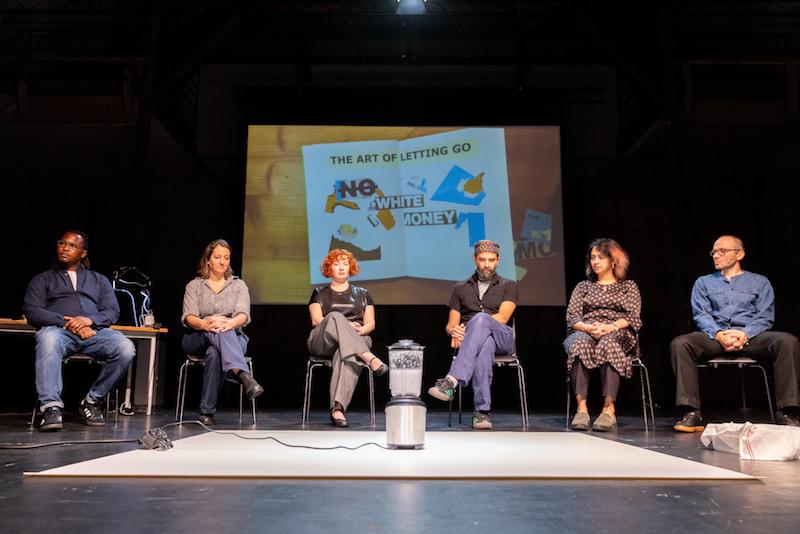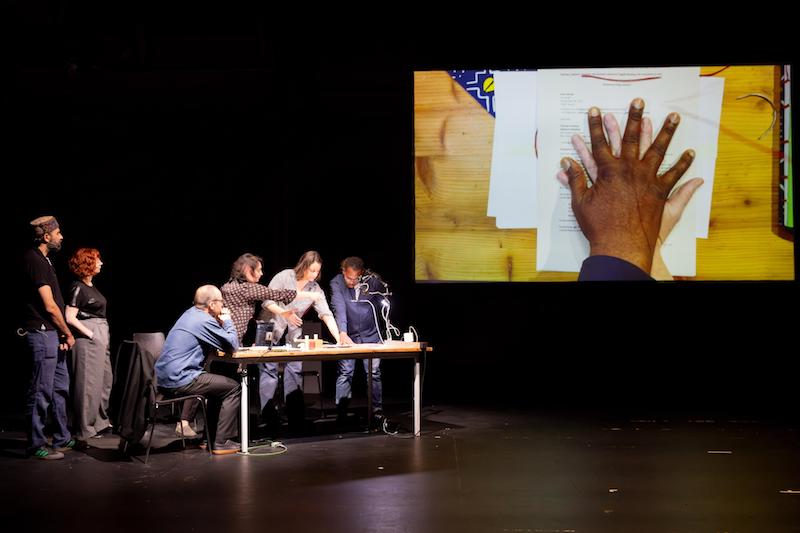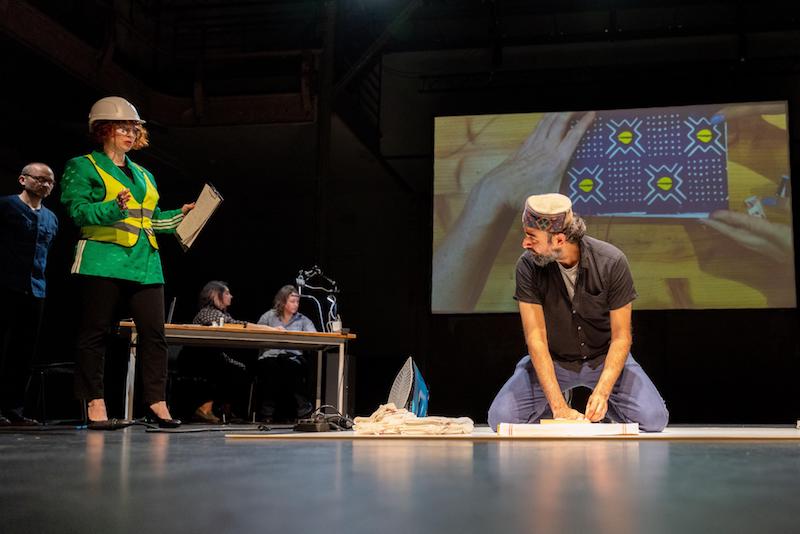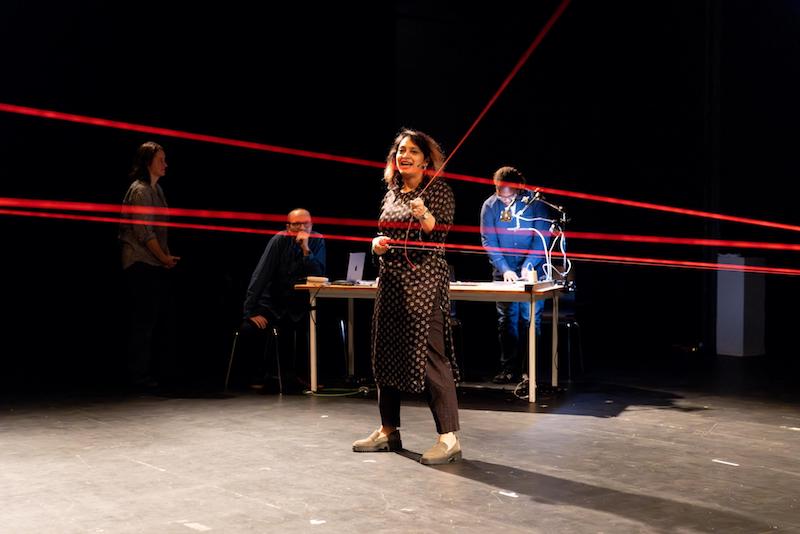by Sumugan Sivanesan // Nov. 26, 2024
‘No! More White Money’ begins before we enter the theater, when Konradin “Kunst” Kunze of Flinn Works—acting as a representative of a funding organization—delivers an opening speech in the foyer. He recalls reading a proposal from an artist that was “beautifully intersectional,” addressing a checklist of terms: “decolonial, patriarchy, anti-semitism…” Announcing that “we are your allies at every intersection,” he offers a metaphor: the cultural sector is a garden but not all plants are tended with equal care, so artists must cultivate resilience. He then ushers us into the theater by paraphrasing Martinican anti-colonial thinker Aimé Césaire: “Life is not a spectacle, but maybe tonight it is!”

Flinn Works & Afra Tafri Creations: ‘No! More White Money,’ 2024, performance at Sophiensaele // Photo by Paul Holdsworth
The piece is a theater performance produced by an international cohort of artist organizations: Afra Tafri Creations (IN/NL), Flinn Works (DE), Drama Queen (IN), Tutùọlá Institute (NG) and Ada Mukhina (RU/DE). It follows on from ‘White Money’ (2021), an exhibition and program of performances produced by Flinn Works, which also premiered at Sophiensaele, and critiqued how the flow of cultural funding from Europe to the so-called “Global South” shapes cultural production. In ‘No! More White Money,’ the performers interrogate the ways in which “white money” dictates aesthetics, access and mobility for artists, playfully laying bare the strings attached to it and attempting to redefine the rules of the game.
After we find our seats, we witness an introductory desktop performance projected onto a large screen. Pages of a booklet are brought towards a camera mounted above a table, showing logos of the sponsors: the Senate Department for Culture and Social Cohesion, Fonds Darstellende Künste, Performing Arts Fund NL. The booklet is then flipped over to pages with logos of the institutions the artists have initiated and under which they sign their names. Details of a contract in German and a budget breakdown are revealed; a co-production agreement for some €59,000. The artists scratch with pens to query the word Zuwendungen, translated as “donations,” before pressing their hands down on the collection of documents, which are bound with string and traced around with a red marker. A pact is made.

Flinn Works & Afra Tafri Creations: ‘No! More White Money,’ 2024, performance at Sophiensaele // Photo by Paul Holdsworth
In the next sequence, the group discusses designs for a promotional poster produced by Aderemi Adegbite of Tutùọlá Institute. A design featuring maps outlining the countries where the performers are based prompts debate over issues of size, relevance and contested boundaries. Adegbite expresses frustration, stressing that his concept is to show where they come from in relation to where the money comes from, before volunteers from the audience are invited to state their preferences and places of origin. ‘No! More White Money’ continues, as each performer comes forward, bringing their issues to the stage and imploring the audience to participate in decisions and in turn reflect on their “appetite for institutional critique.”
Adegbite inaugurated the Tutùọlá Institute as a legal, non-profit Yoruba cultural organization for Flinn Work’s initial ‘White Money’ program. Since then, he recalls having spent more than 3,000 hours on funding applications. With none of them successful, he is now constructing a brick-and-mortar institute by exchanging skills. Playing on the duality of the Tutùọlá Institute as both a cultural center and an artwork, he solicits for funds to complete the roof—a work of art that he jokes will eventually be donated to Berlin’s Humboldt Forum. Indeed, as ‘No! More White Money’ unfolds, the Tutùọlá Institute is foregrounded as a pivotal collaborator, as well as a dramatic device around which the performance turns.

Flinn Works & Afra Tafri Creations: ‘No! More White Money,’ 2024, performance at Sophiensaele // Photo by Paul Holdsworth
In its final act, a book being assembled on the table during the performance is brought to auction. Alongside original texts, collages and artists’ pages, it includes an unpublished photo taken in Wolfgang Tillmans’ apartment, where some of the artists are staying, and is hand-bound within a dust jacket fashioned out of traditional Nigerian fabrics. With bidding starting at €10, it is sold some minutes later for a mere €90! Bids notably drop off after €50, suggesting that tonight’s audience are predominantly artists as well, with one couple divulging that their bid drew on their rent money. Later in the bar, a rumor circulates that the successful bidder was from one of the funding organizations and would have matched bids to protect their investment.
At the conclusion of ‘No! More White Money,’ Adegbite calls an Ifa oracle in Lagos to confirm that the money collected should be accepted, suggesting that donations bear consequences that might not be wise take on. When someone from the audience asks if they can contribute later, they are told that investments are only possible within the confines of the performance. The piece reveals itself to be a storytelling ritual, a way to share knowledge, raise awareness and redistribute wealth.

Flinn Works & Afra Tafri Creations: ‘No! More White Money,’ 2024, performance at Sophiensaele // Photo by Paul Holdsworth
Returning to the garden analogy, it seems the once colorful “intercultural” showpiece of a re-unified Berlin is now being weeded and selectively tended with patches left strategically neglected. Funding cuts, rising costs, lack of space, censorship and cancellations suggest that not all will survive the coming winter. While the Goethe Institut and other organizations whose remit is cultural diplomacy may be guided by different agendas, the timely dissolution of Olaf Scholz’s coalition government on the night of the premiere, due to fundamental disagreements about how to address a budget shortfall, indicates that further cuts to culture are inevitable. We don’t need an oracle to predict the future of arts funding in Berlin, so what will we do when the money runs out? No doubt, artists, like seeds, will go with the winds of opportunity. Given the current political climate in Germany, some artists are choosing not to work here. This participatory exchange-as-performance begs the question: as other opportunities arise in Europe, is Berlin still worth the effort?



















